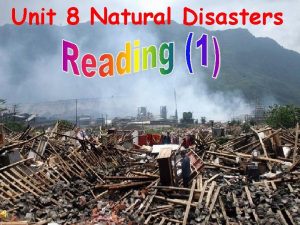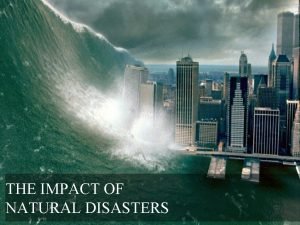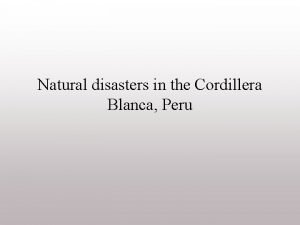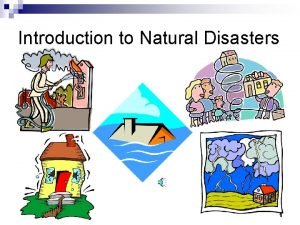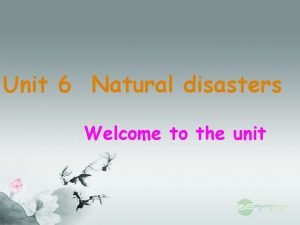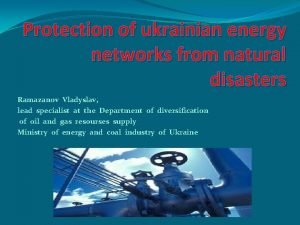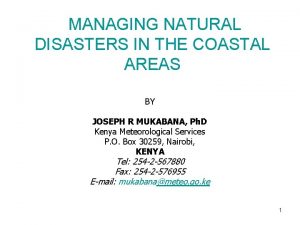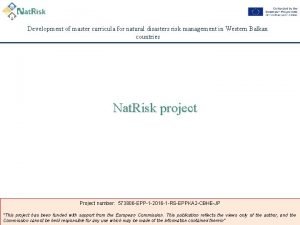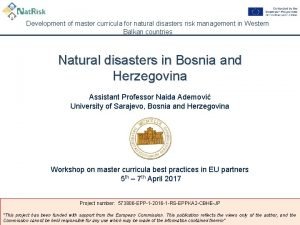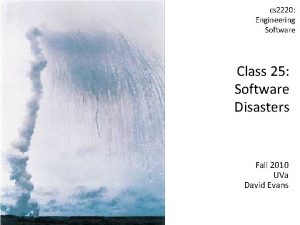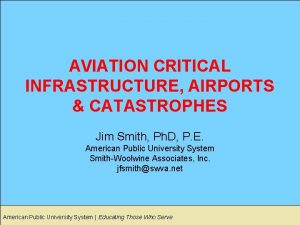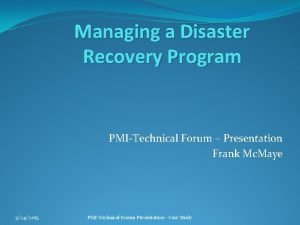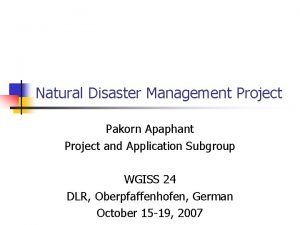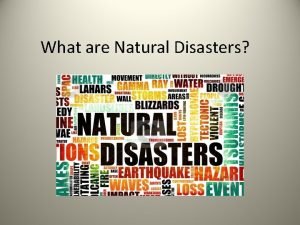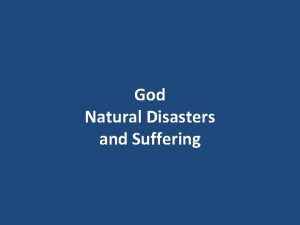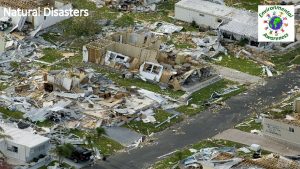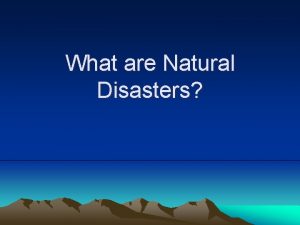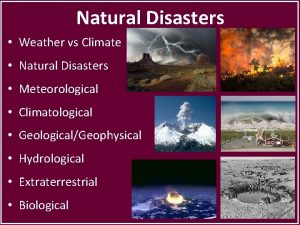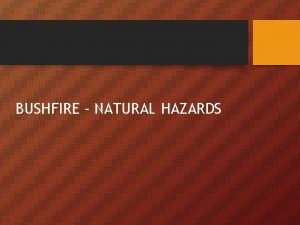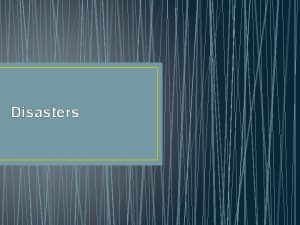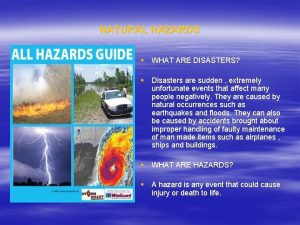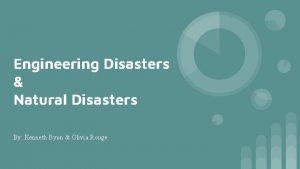Unit 19 Natural Disasters pt 1 NATURAL DISASTERS























- Slides: 23


Unit 19: Natural Disasters pt 1

NATURAL DISASTERS • An event that occurs naturally and affects the earth’s surface and environment – Man made disasters occur as a result of human error and or accidents

NATURAL DISASTERS • Can be land, water or weather disasters – Land disasters occur due to movement of the earth’s land surface • Volcanic eruptions, earthquakes, landslides and avalanches – Water disasters involve huge amounts of water moving at a greater speed • Floods, storms and tsunamis – Weather disasters occur due to extreme changes in weather elements • Tornadoes, droughts, blizzards, heat waves

Unit 19: Typhoons TYPHOONS

Unit 19: Typhoons WHAT IS A TYPHOON? • Large tropical storms that produce strong winds and large volumes of rains • Occurs during certain periods of the year • Eye of the typhoon is a low pressure region where the winds spin – Strong winds and rains surround the eye of the storm

Unit 19: Typhoons EFFECTS OF TYPHOONS • ON THE ENVIRONMENT – May cause landslides, uproot trees, – May produce a storm surge (rise in the water level as the typhoon makes a land fall) which may result to flooding • ON PROPERTIES – Water and wind damage of properties such as cars, houses, and even death may result

Unit 19: Typhoons SIGNS OF AN APPROACHING TYPHOON • Satellite pictures – Show speed of wind, clouds and storms – Can estimate the course and strength of a typhoon • Aircrafts pick up info by flying close to it • Ships monitor oceanic temp • Weather radars on land

Unit 19: Typhoons MEASURES TO BE OBSERVED • Before a typhoon – – – – Turn off and unplug appliances Secure glass windows Secure objects which may be carried by the wind If and when needed, go to an evacuation center Bring an emergency kit If not, stay indoors and away from windows Hide in basements and underground bunkers Have an adequate supply of clothes, food, batteries, drinking water; have portable radio

Unit 19: Typhoons MEASURES TO BE OBSERVED • During a typhoon – Continue to stay indoors – Monitor radio for updates

Unit 19: Typhoons MEASURES TO BE OBSERVED • After a typhoon – Be careful in going around the premises • Be on the lookout for broken materials, including electrical lines – Ensure structural integrity of your house – Stay away from flood waters, if possible

Unit 19: Volcanic Eruptions ERUPTION VOLCANIC S

Unit 19: Volcanic Eruptions VOLCANOES • An opening in the ground though which lava, hot gases, ash and rocks are released at a great force. • They are formed when tectonic plates move towards or away from each other • The PLATE TECTONIC theory explains why plates move

Unit 19: Volcanic Eruptions HOW A VOLCANO ERUPTS pressure and erature causes ma to force its ut of the crust Blocked VENT may block the magma allowing more pressure to build up When the pressure is great, magma will shoot itself through the vent and will go out through the CRATER


THE PACIFIC RING OF FIRE Unit 19: Volcanic Eruptions • Belt around the Pacific Ocean • Active volcanoes are located due to the active movement of the plates

Unit 19: Volcanic Eruptions TYPES OF VOLCANOES • Erupts regularly in the past and will do so again in the future Active Taal Volcano • A currently inactive volcano but still shows signs of eruption Dormant Three Sisters in Colorado • Scientists consider them unlikely to erupt Extinct Cococachi in Equador

Unit 19: Volcanic Eruptions DANGERS OF AN ERUPTION • Explosive (pyroclastic) eruptions may – Eject ash, gas and very big rocks • Makes breathing difficult • Smell of sulphur is foul – Hot lava may destroy outlying properties • Non explosive eruptions may also destroy properties

Unit 19: Volcanic Eruptions SIGNS OF A VOLCANIC ERUPTION A volcanic eruption may be predicted • • As magma starts to move – Seismographs and seismometers detect and record this – Gas and steam emissions – Tremors and bulges

Unit 19: Volcanic Eruptions MEASURES TO BE OBSERVED • Before a volcanic eruption – For those living near volcanoes – Keep eye and mouth protection – Put together an emergency kit – Stay away from permanent danger zones – Do not resist evacuation • Know evacuation route

Unit 19: Volcanic Eruptions MEASURES TO BE OBSERVED • During a volcanic eruption – Stay clear of lava and other pyroclastic materials – Avoid rivers and other low lying areas • Route taken by hot lava and lahar (water and mud) – Protect arms and legs, as well as eyes and mouth – Close windows and doors to prevent ash from getting in the house

Unit 19: Volcanic Eruptions • MEASURES TO BE OBSERVED After a volcanic eruption – Remove ash from roofs (have adults do this) – Continue wearing protective gears – Stay away from rivers which may be routes of lahar

sources • • • gadgets. boing. net wunderground. com worldatlas. com pacificislandparks. com volcanochild. co. uk Istockphoto. com ecuador-travel. net ellerbruch. nmu. edu eos. higp. hawaii. edu armageddononline. org oml 13. glogster. com
 Natural hazards vs natural disasters
Natural hazards vs natural disasters Taiwan earthquake
Taiwan earthquake Unit 9 natural disasters
Unit 9 natural disasters Natural disasters listening
Natural disasters listening Environmental effect of disaster
Environmental effect of disaster Cordillera natural disasters
Cordillera natural disasters Natural disasters introduction
Natural disasters introduction Ancient natural disasters
Ancient natural disasters Three natural disasters
Three natural disasters Conclusion of natural disasters
Conclusion of natural disasters Conclusion on disaster management ppt
Conclusion on disaster management ppt Natural calamities definition
Natural calamities definition Natural disasters definition
Natural disasters definition Natural disasters
Natural disasters Natural disasters
Natural disasters Ancient natural disasters
Ancient natural disasters Unit 10, unit 10 review tests, unit 10 general test
Unit 10, unit 10 review tests, unit 10 general test Aqa english language paper 2 rail disasters mark scheme
Aqa english language paper 2 rail disasters mark scheme Chapter 8 emergency care first aid and disasters
Chapter 8 emergency care first aid and disasters Software engineering disasters
Software engineering disasters Man made disasters conclusion
Man made disasters conclusion Most historians agree that military disasters
Most historians agree that military disasters Types of disasters
Types of disasters What are disasters
What are disasters

